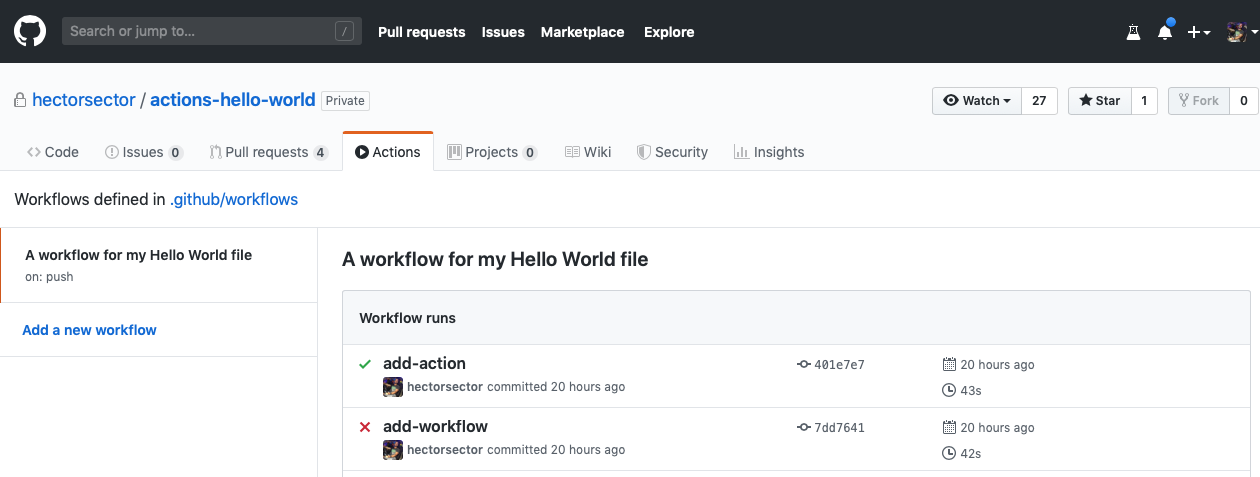-
Notifications
You must be signed in to change notification settings - Fork 0
New issue
Have a question about this project? Sign up for a free GitHub account to open an issue and contact its maintainers and the community.
By clicking “Sign up for GitHub”, you agree to our terms of service and privacy statement. We’ll occasionally send you account related emails.
Already on GitHub? Sign in to your account
add docker file #2
Conversation
|
Nice work, you committed a ENTRYPOINT ["/entrypoint.sh"]The Step 2: Add an entrypoint scriptAn entrypoint script must exist in our repository so that Docker has something to execute. ⌨️ Activity: Add an entrypoint script and commit it to your branch
I'll respond when I detect a new commit on this branch. |
|
Nice work adding the In Next, we'll define a workflow that uses the GitHub Action. action.ymlAll actions require a metadata file that uses YAML syntax. The data in the metadata file defines the Step 3: Add an action metadata fileWe will use an ⌨️ Activity: Create action.yml
I'll respond when I detect a new commit on this branch. |
|
Next, we'll define a workflow that uses the GitHub Action. Workflow FilesWorkflows are defined in special files in the Workflows can execute based on your chosen event. For this lab, we'll be using the We'll break down each line of the workflow in the next step. Step 3: Start your workflow fileFirst, we'll add the structure of the workflow. ⌨️ Activity: Name and trigger your workflow
Trouble pushing? Click here.The It is possible that you are using an integration (like GitHub Desktop or any other tool that authenticates as you and pushes on your behalf) if you receive a message like the one below: To https://github.com/your-username/your-repo.git
! [remote rejected] your-branch -> your-branch (refusing to allow an integration to update main.yml)
error: failed to push some refs to 'https://github.com/your-username/your-repo.git'I'll respond when I detect a new commit on this branch. |
|
Nice work! 🎉 You added a workflow! Here's what it means:
Next, we need to specify a job or jobs to run. ActionsWorkflows piece together jobs, and jobs piece together steps. We'll now create a job that runs an action. Actions can be used from within the same repository, from any other public repository, or from a published Docker container image. We'll use an action that we'll define in this repository. We'll add the block now, and break it down in the next step. Step 4: Run an action from your workflow fileLet's add the expected action to the workflow. ⌨️ Activity: Add an action block to your workflow file
Trouble pushing?The It is possible that you are using an integration (like GitHub Desktop or any other tool that authenticates as you and pushes on your behalf) if you receive a message like the one below: To https://github.com/your-username/your-repo.git
! [remote rejected] your-branch -> your-branch (refusing to allow an integration to update main.yml)
error: failed to push some refs to 'https://github.com/your-username/your-repo.git'I'll respond when I detect a new commit on this branch. |
|
Nice, you just added an action block to your workflow file! Here are some important details about why each part of the block exists and what each part does.
Your action has been triggered!Your repository now contains an action (defined in the This action will run any time a new commit is created or pushed to the remote repository. Since you just created a commit, the workflow should have been triggered. This might take a few minutes since it's the first time running in this repository. Seeing your Action in actionThe status of your action is shown here in the pull request (look for All checks have passed below), or you can click the "Actions" tab in your repository. From there you will see the actions that have run, and you can click on the action's "Log" link to view details. Step 5: Trigger the workflow⌨️ Activity: See your action trigger the workflow
I will respond when I detect your action has run and reported a status.
|
There was a problem hiding this comment.
Choose a reason for hiding this comment
The reason will be displayed to describe this comment to others. Learn more.
Success! 🎉 Your workflow ran! You can see the output here.
You should see the string "Hello world, I'm Mona!" printed at the bottom to stdout.
Step 6: Incorporate the workflow
As a final step, merge this pull request so the action will be a part of the master branch.
Anyone that uses this repository, and any future code can benefit from this workflow and your new action!
⌨️ Activity: Merge your workflow into the master branch
- Merge this pull request
- Delete your branch
I'll respond when I detect this branch has been merged.
Great work merging your pull request! I created a new issue, look for my final response there. |


No description provided.